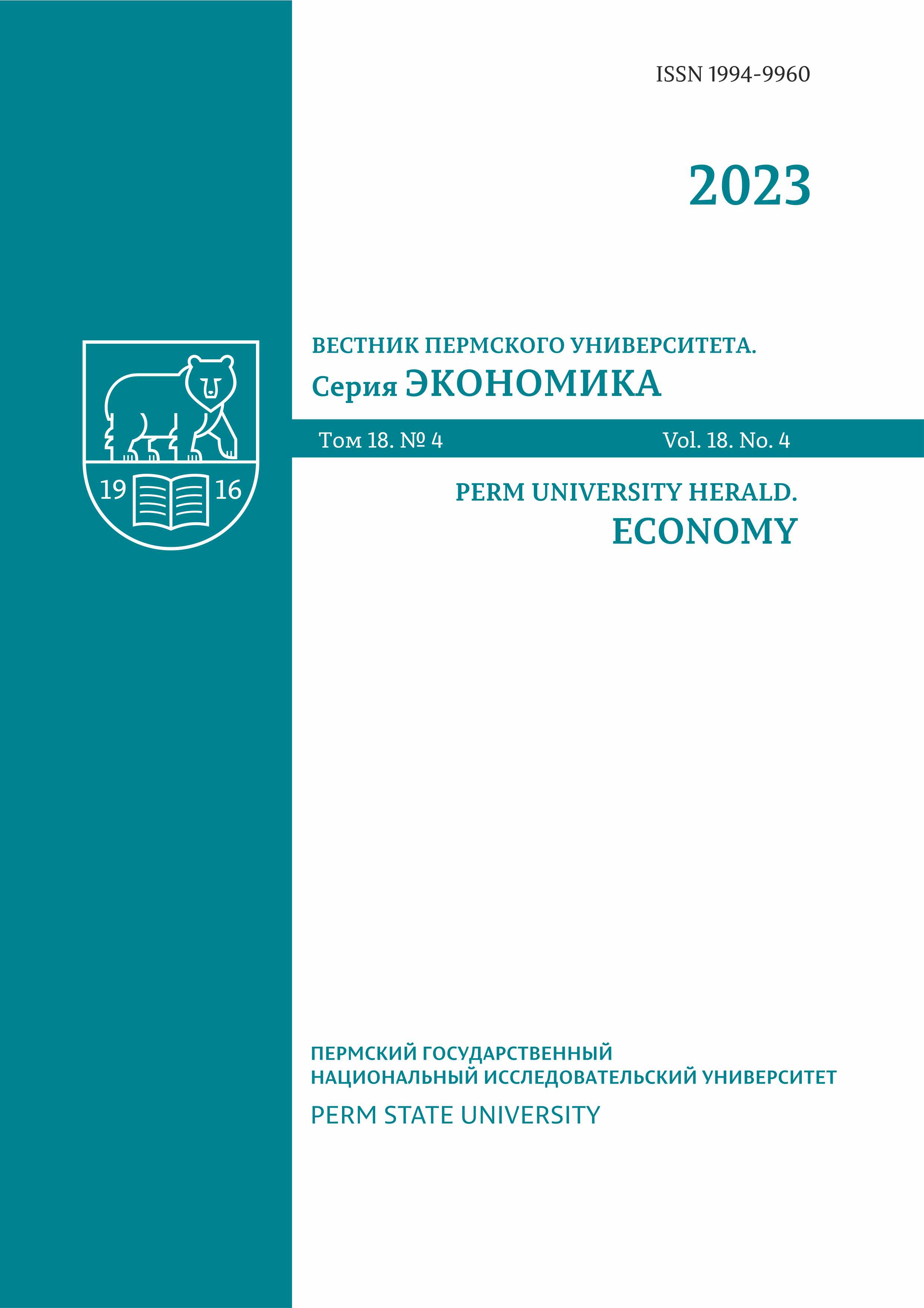Assessing the size of the shadow economy in an industrial region (case study of the Donetsk People’s Republic)
DOI:
https://doi.org/10.17072/1994-9960-2023-4-409-422Abstract
Introduction. Combating tax evasion, the shadow economy and unofficial (illegal) employment are important policy goals in every region. Achieving those goals requires various resources; therefore, it is important to determine the size of the shadow economy to use the resources efficiently.
Purpose. The paper aims at developing and testing a methodology for neural simulation estimates to find the size of the shadow economy in an industrial region taken as an example, i.e. the Donetsk People’s Republic.
Materials and Methods. The study refers to the data from the World Bank Group’s Ease of Doing Business Index and data about the size of the shadow economy calculated with L. Medina and F. Schneider’s methodology. The neural network learns from the generated data array of 17,160 values for the economies of the world for 2006–2015 with the Statistica software package. The result was then used to estimate the value of the shadow economy in the industrial region.
Results. The hypothesis that the Ease of Doing Business Index and the size of the shadow economy are correlated has been proposed and tested. The indicators of the Ease of Doing Business Index and the size of the shadow economy by country were sampled. The neural network was taught to assess the size of the shadow economy with the Statistica software package. The values of the Ease of Doing Business Index have been determined for the Donetsk People’s Republic. The taught neural network calculates the size of the shadow economy in the Donetsk People’s Republic and establishes that its size ranges between 30 and 40 %. The debatable issues of applying the suggested algorithm for calculating the size of the shadow economy in an industrial region are outlined.
Conclusion. It is often not the irresponsibility of the entrepreneurs themselves that leads to the shadowing of the economy, but the difficulties with the business legalization and exorbitant taxes. The measures of minimizing the level of the shadow economy in the Donetsk People’s Republic are described. The suggested information will be useful for those who determine the economic policy of the region.
Keywords: regional economy, industrial region, shadow economy, ease of doing business, calculation algorithm
For citation
Polovyan A. V., Sinitsina K. I. Assessing the size of the shadow economy in an industrial region (case study of the Donetsk People’s Republic). Perm University Herald. Economy, 2023, vol. 18, no. 4, pp. 409–422. DOI 10.17072/1994-9960-2023-4-409-422. EDN QIAJJG.
References
- Mazur І. І. Motivatsіya sub’єktіv tіn'ovoї ekonomіchnoї dіyal'nostі. Ekonomіchna teorіya = Economic Theory, 2006, no. 4, pp. 40–53. (In Ukrainian).
- Andrews D., Caldera Sánchez A., Johansson Å. Towards a better understanding of the informal economy. OECD Economics Department Working Papers, No. 873. OECD Publishing, 2011. 46 p. DOI 10.1787/5kgb1mf88x28-en
- Breusch T. Estimating the Underground Economy using MIMIC Models. Econometrics. University Library of Munich, Germany, 2005. 36 p. Available at: https://core.ac.uk/download/pdf/9310351.pdf (access date 10.07.2023).
- Contini B. The second economy. The underground Economy in the United States and Abroad. Ed. by Vito Tanzi, Lexington Books, 1982. 340 p.
- Sutherland E. H. Is “White Collar Crime” Crime? American Sociological Review, 1945, vol. 10, no. 2, pp. 132–139. DOI 10.2307/2085628.
- Becker G. S. Crime and Punishment: An Economic Approach. S. Becker, W. M. Landes (eds). Essays in the economics of crime and punishment. NBER, 1974, pp. 1–54. Available at: http://www.nber.org/chapters/c3625 (access date 10.07.2023).
- Hart K. Informal economy opportunities and the urban employment in Ghana. Journal of Modern Africa Studies, 1973, vol. 11, no. 1, pp. 61–89. DOI 10.1017/S0022278X00008089.
- Volkov V. V. Silovoe predprinimatel'stvo: ekonomiko-sotsiologicheskii analiz. Moscow, 2005. 353 p. (In Russ.).
- Coleman J. W., Cressey D. R. Social problems. 4th New York, Longman Higher Education, 1990. 571 р.
- Vishnevskii V. P., Vetkin A. S. Ukhod ot uplaty nalogov: teoriya i praktika. Donetsk, In-t ekonomiki promyshlennosti, 2003. 228 p. (In Russ.).
- Feige E. L. How Big is the Irregular Economy. Challenge, 1979, vol. 22, issue 5, pp. 5–13. DOI 10.1080/05775132.1979.11470559.
- Frey B. S., Weck H. Estimating the shadow economy: A “naive” approach. Oxford Economic Papers, 1983, vol. 35, issue 1, pp. 23–44. DOI 10.1093/oxfordjournals.oep.a041582.
- Schneider F. G., Williams C. C. The Shadow Economy in Europe, 2013. London, The Institute of Economic Affairs, 2014. 186 p.
- Mel'nichuk T. V. Genezis teorii belovorotnichkovoi prestupnosti v kriminologicheskoi nauke. Vіsnik Zaporіz'kogo natsіonal'nogo unіversitetu = Bulletin of Zaporizhzhia National University, 2015, no. 2 (1), pp. 192–199. (In Russ.).
- Masakova I. D. Opredelenie parametrov tenevoi ekonomki. Voprosy statistiki = Statistics Issues, 1999, no. 12, pp. 22–27. (In Russ.).
- Orekhovskii P. A. Statisticheskie pokazateli i tenevaya ekonomika. Rossiiskii ekonomicheskii zhurnal = Russian Economic Journal, 1996, no. 4, pp. 77–83. (In Russ.). EDN YWNMPJ.
- Barsukova S. Yu. Srashchivanie tenevoi ekonomiki i tenevoi politiki. Mir Rossii. Sotsiologiya. Etnologiya = Universe of Russia. Sociology. Ethnology, 2006, vol. 15, no. 3, pp. 158–179. (In Russ.). EDN HUBUVZ.
- Medina L., Schneider F. Shadow Economies Around the World: What Did We Learn Over the Last 20 Years? IMF Working Papers, 2018, vol. 2018, issue 017. 76 p. DOI 10.5089/9781484338636.001.
- Rubin D. B. Multiple Imputation for Nonresponse in Surveys. New York, Wiley, 1987. 258 p.
- Schneider F. Hiding in the Shadows: The Growth of the Underground Economy. Washington, IMF, 2002. 23 p. (In Russ.). Available at: https://www.imf.org/external/pubs/ft/issues/issues30/rus/issue30r.pdf (access date 10.07.2023).
- Kaufmann D., Kaliberda A. Integrating the Unofficial Economy into the Dynamics of Post Socialist Economies: A Framework of Analyses and Evidence. Policy Research Working Paper, No. 1691. Washington, D.C., The World Bank, 1996. 44 р. DOI 10.1596/1813-9450-1691.
- Polovyan A. V. Otsenka razmera tenevoi ekonomiki promyshlennogo regiona. Vestnik Instituta ekonomiki promyshlennosti = Bulletin of Institute of Economic Industry, 2015, no. 1 (69), pp. 53–64. (In Russ.).
- Stiglits J., Sen A., Fitoussi J.-P. Neverno otsenivaya nashu zhizn': Pochemu VVP ne imeet smysla? Doklad Komissii po izmereniyu effektivnosti ekonomiki i sotsial'nogo progressa. Moscow, 2016. 216 p. (In Russ.).











